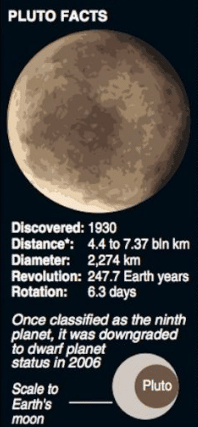You must have heard about Pluto, the former 9th planet in the solar system. Most of you may also know about how Pluto lost its planetary status and became a dwarf planet. However, do you know how this mysterious dwarf planet received its name?
What Is Pluto?
Before we get into its discovery and naming, let us understand what pluto is. Pluto, formerly thought to be the ninth and most distant planet from the sun, is now the solar system’s biggest known dwarf planet. It is also one of the largest known members of the Kuiper Belt, a mysterious zone beyond Neptune’s orbit considered to be home to hundreds of thousands of stony, ice planets each spanning 62 miles.

Now let’s look at some specific characteristics of the planet. Pluto is diverse and intriguing, with mountains, valleys, plains, craters, as well as ice. It has a diameter of around 1,400 miles, which means it is about half the breadth of the United States. The planet is approximately 3.6 billion miles away from the Sun and has a thin atmosphere mostly made of nitrogen, methane, and carbon monoxide. Hence, Pluto’s average temperature is -387°F (-232°C), making it too frigid to support life.

The Discovery and Naming of the Dwarf Planet
Identifying the Dwarf Planet Pluto
The Discovery of pluto is quite an interesting tale. An American astronomer Percival Lowell proposed the planet’s existence in 1905, despite never having seen it. Lowell, who was studying some unusual nuances in the orbits of Neptune and Uranus at the time, guessed that the gravity of an unknown planet was in effect, causing the changes he observed.
Then, Clyde Tombaugh, an American astronomer, spotted Pluto after Lowell’s death in 1930.
Who Named the Dwarf Planet Pluto and Why?
Identification of pluto generated buzz all across the world. Lowell Observatory, which had the authority to name the new object, was bombarded with hundreds of letters with potential names for the planet from all over the World.
The letters and telegrams came from 37 of the then-48 states, with the most coming from Massachusetts, New York, and Pennsylvania. Suggestions also came in from Canada, Korea, Germany, England, and Mexico. In total, the Lowell Observatory had about 171 possible names, with 13 appearing at least five times.
Names Based on Greek and Roman Deities
Roman Deities serve as the bases for the names of all planets, except for Earth. Because Roman astronomers could see the planets with the naked eye, they named the planets Venus, Mars, Mercury, Jupiter, and Saturn thousands of years ago, after their roman gods and goddesses. Most suggestions for the name of the planet followed this tradition. Six of the names suggested were based on gods, and four were based on goddesses.
Interestingly, the high number of proposals for a female name came from the increasingly outspoken women, whose social standing were improving dramatically during the period. In fact, one letter proposed six names (Athena, Psyche, Juno, Circe, Atalanta, and Cassandra) and was signed, “Star-rover, She is not a Feminist. For eons, men have been the Lords of Creation. However, given that women are vying for the top of the universe, giving the new planet a feminine name would be considered a complement to the sex. In fact, it may inspire even higher dreams”
Other Names Suggested by People
Many names were also inspired by people linked with Planet X, notably Percival Lowell. These include simple names like Lowell or Percival, as well as amalgamations like Percilo, Perlo, and Perlow (the initial letters of his first and last names), and Percius (Percival and his country, the United States).
Gale Dismukes of Juneau, Alaska, chose the name Tom Boy to commemorate the discoverer of the new planet, Clyde Tombaugh. She even composed a poem named “The Planet Speaks”, and attached that to her letter as well. Her poem is as mentioned below:
“The Planet Speaks”
“Tom Boy” “Tom Boy”
Let it be my name
Surely Mr. Tombaugh
Beats in this game.
Playing “Hide and seek”
I often have thought
I, should like to be
discovered
By one self-taught.
Let the joyous tidings
Ring the world around
“Tom Boy” “Tom Boy”
The latest Planet found.”
Lastly, Karl Underhill of New Hampshire came up with one of the cutest ideas. “If I had discovered the new trans-Neptunian planet, I would call it Jean after my two-year-old daughter,” he wrote. “I’m not sure what the meaning of the name Jean is, but it means everything to me.”
A Letter With The Name Pluto

Fascinated by ancient mythology, Venetia Burney, an eleven-year-old schoolgirl in Oxford, England, offered the name Pluto after the Greek or Roman deity of the underworld. Her grandfather Falconer Madan, a former librarian at the University of Oxford’s Bodleian Library, proposed it to astronomy professor Herbert Hall Turner, who telegrammed it to his colleagues in the United States.
Venetia Burney explained that the name was appropriate for the new planet since it was hiding for so long, and the Roman deity Pluto could vanish at will.
Finalizing the Name of the Planet
Each Lowell Observatory member voted to shortlist a few from the long list of over a hundred names. This process yielded three candidate names. They were Minerva (which was already the name of an asteroid), Cronus (which had lost popularity due to being offered by the controversial astronomer Thomas Jefferson Jackson See), and Pluto. Finally, Pluto earned a unanimous vote of approval. The fact that the first two letters of Pluto were the initials of Percival Lowell, aided in the ultimate decision of naming.
Therefore, on May 1, 1930, the name was first published. Following this, Venetia received a reward of £5, which is equal to 300 GBP or 450 USD in 2014.
How Did the Name Pluto Become Popular Among the Masses?
Pop culture quickly adapted the moniker “Pluto”. It was used everywhere, from the Magic School Bus to Doctor Who. In fact, Walt Disney was also likely influenced by the planet when he introduced a canine sidekick for Mickey Mouse named Pluto in 1930. Furthermore, Glenn T. Seaborg called the newly found element plutonium after Pluto in 1941, continuing the practice of naming elements after newly discovered planets that began with uranium, named after Uranus, and neptunium, named after Neptune.
Summing It Up!
Naming the dwarf planet Pluto was by no means an easy task. It took several weeks and a lot of deliberation to finalize this name. However, all that time and effort was well worth it, as the hidden astronomical body could not have been given a better name. To know more about this planet, visit the Podium School Blog.
Share with your friends





